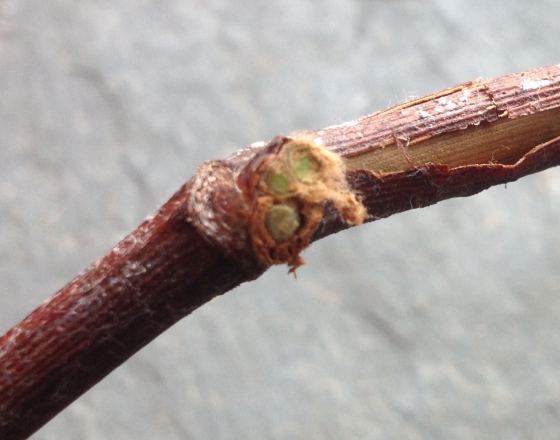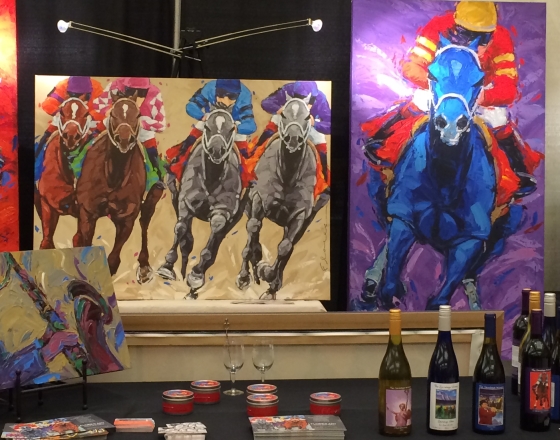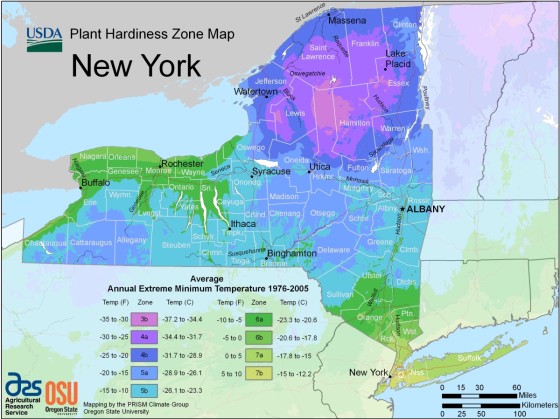The last snow piles are finally melted after a long winter in the North Country, and while the the season may have been oppressive, those intrepid enough to dwell in it are rebounding with a vigor of surprising quality. This exuberance was evident at the Saratoga City Center this past Saturday when nearly a thousand visitors poured into the inaugural Taste of Upstate event to explore what the region has to offer.
In a similar vein, good reports have been pouring in regarding the fortitude of the cold-climate fruits planted in these areas, and of how well they’ve handled a good old fashioned winter.
I, of course, did due diligence at home and took bud samples in my own trial vineyard to assess the damage. 2013 was a tough year between the early wet, and a long, late, voracious season of beetles. Not all of the new wood matured and quite a bit died back. However, any wood that hardened off completely on the hybrid vines actually has fully live buds — primary, secondary and tertiary.
But, on the dozen riesling vines we’ve got don’t have a single bud left alive above ground, even though there had been deep insulating snow cover. Granted there may be protected places in the Champlain Valley where some vinifera buds survived, but based on latest reports those instances might be very far and few between. The cold-climate hybrids finally got a good test this winter, and it would seem that true to their breeding, they will be be prepared for a good fruit set this year.
The temps went so low at our place this winter that I stopped trusting the thermometer after -28F. Readings of 20F or lower was the general consensus in the North Country, and given that many cold climate vines are reported to handle even lower temperatures, the positive responses in their favor are certainly within parameters. The USDA plant hardiness zone map for New York state really does tell the story of what, in general, will do better where…and why producers should use it to keep a weather eye on long term sustainability.
Given what I saw at the Taste of Upstate festival, and based on the response from attendees, I’d say the consumer portion of the sustainability formula is starting to crystallize. These tasters want to see local wines succeed, and so it is up to producers to make choices that will allow them to deliver on a promise that their customers hope they can make. This was the winter that separated the Zone 5s from the Zone 4s and even did some winnowing within those warmer ranks. In general, reports of winter survival rates were favorable among the die hard vines, and not so upbeat among the more marginal varieties. A number of folks shared information with me either via email or at the festival.
Gerry Barnhart at Victory View Vineyards on the Upper Hudson Valley Wine Trail was sounding confident: “Essentially no damage on our Marquette, Marechal Foch, La Crescent and LaCrosse. Some damage on our Melody (our least hardy variety) in the range of 30 – 50% primary bud loss. ”

About 50 miles south of there, Carlo DiVito of Hudson-Chatham Winery said “We have seen only about 10% bud kill, but especially in the northern valley, most of the wineries have hybrids and Minnesota varieties that performed well. Vinifera seemed to have survived as well. Just met with a group of HV winemakers last night. So far, so good. Temperatures did dip down to the minus 9 degree mark, or thereabouts, but so far bud kill is at a minimum. Of course wood damage won’t be known until June or July.”
When I spoke to Lori Randazzo from Coyote Moon Vineyards which is situated up in Clayton on the St. Lawrence, at the Taste of Upstate event, she was more circumspect, indicating that things had looked good so far despite a recorded low of -37F, but that they were reserving judgement until after bud break, and the last chance of frost.
Amazing Grace Vineyards, in Chazy, is a bit farther north than anyone else in Clinton County in the Lake Champlain Valley, nearing the Canadian border, and usually about 5 degrees colder at any point in time. Mary Fortin reported that their more tender vines had a very hard go, with plants rated at 4b really suffering. They will be looking forward, in earnest, to the emergence of renewal wood.
Richard Lamoy at Hid-In-Pine Vineyard outside of Plattsburgh, turned in a quantified report to the Cornell Extension, which he shared with me for this article. His data certainly indicates the cutoff line between what is feasible and what is not, based on the the extreme low reaches that we should expect to see.
“Here we had a cool autumn last year so the vines had a chance to harden off normally with no early freezes. That helped the vines prepare for winter. At my place we had three days with low temperatures of slightly greater than -20F. That puts it in the expected USDA Hardiness zone of a 4b (although the new model says a 5a). Therefore I would expect some damage to vines with a rating of hardiness zone 5. Did this happen in reality? Yes.”
[box_light]
Variety USDA Zone % Winter Bud Kill(primaries)
Catawba 5 >75%
Cayuga 5 >75%
Chardonnel 5 >90%
Steuben 5 >75%
Leon Millot 4-5 >30%
La Crosse 4 >15%
Petite Amie 4 < 10%
St. Pepin 4 <10%
Marquette 3 <20%
La Crescent 3 <20%
Frontenac 3 <10%
[/box_light]
“This reinforces what we have tried to teach. Grow varieties that can withstand the cold years, not just the normal ones.”
The lessons Lamoy takes from a winter like this are twofold. That we need to be prepared to adjust our pruning regimen based on kill ratios to leave extra buds if we have crop targets we are looking to hit, and that we really need to be judicious about variety selection, choosing fruit that will be reliable and economically viable for commercial production. This is an important consideration because those upstate wine lovers who are psyched about trying the local goods, are forming their expectations quickly. The way I look at it, why fight Mother Nature, and besides, I think some of the deeply cold climate grapes can simply make better wine than the more questionable ones.
For a first time event, it was an impressive turnout at the Taste of Upstate. Attendants were from a wide range of demographics across generational, social and economic groups, as well as from across the spectrum of wine knowledge. The one thing they all shared in common was an open-mindedness about what producers were pouring from the Upper and Lower Hudson Valleys, to the Finger Lakes and Thousand Islands…and while there were plenty of tasters for the $25 gate, there were plenty who were also eager to purchase what they found, and producers were selling out their stocks.
I was able to meet up with some producers that I see now and again, and to make some new connections with people I’d like to visit in the future. I also tried a bunch of interesting stuff and brought some things home to share with friends: Marechal Foch and La Crescent from Victory View, another Foch from Swedish Hill, a Rosette from Capoccia for our annual rosé party, the ‘orange’ rosé from Hudson-Chatham, and an intriguing melomel from Amorici. I have to set a limit because I could get carried away collecting specimens at a gig like this one, so I’ll just have to put it on the calendar for next year. Meanwhile, it’s time to get back to the vineyards and to prepare to make the shift from taking bud samples to bug samples, as the season moves out of dormancy and into revival.



